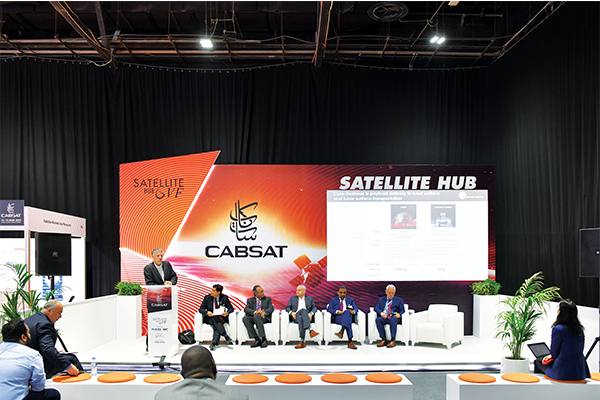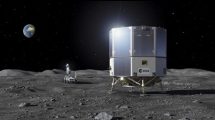
By Martin Jarrold
Late last year, GVF’s Secretary General attended the most recent of the quadrennial gatherings of the International Telecommunication Union’s Sector R (the Radiocommunication Bureau), popularly called the World Radiocommunication Conference (WRC). Regulators and industry representatives gathered to discuss competing claims for spectrum among different radiocommunications services, determining spectrum allocations between the satellite and other sectors such as IMT. It was an opportunity to create new spectrum rights for satellite and provide operational flexibility. These opportunities were largely successful.
Receiving most attention from the satellite industry was the proposed allocation of over 33GHz of spectrum to IMT, though actually only a little over half of that was ultimately identified for IMT, and important protections for key satellite spectrum in the C-, Ku- and Ka-bands were secured.
Identification of spectrum for mobile uses via satellite, providing high-bandwidth services in transport, also saw a positive outcome. ESIM (Earth Stations in Motion) satellite services are enjoying a growth cycle, which is forecast to continue.
WRC-19 increased the spectrum for ESIM services in the 28GHz band and harmonised the international framework for authorising ESIM services. The Conference also decided to have a study performed for WRC-23 to define the conditions for communications of ESIMs with geostationary satellites.
A further positive outcome was the decision to allocate spectrum, 51.4GHz to 52.4GHz, for uplinks for fixed satellite service (FSS) gateways. This will improve services to end users by freeing Ka-band spectrum for user uplinks, which can be used to provide new services such as 5G.
Also established were new rules regarding NGSO satellites, which mitigate the risk of signal interference between the NGSOs and the GSOs sharing the same frequency bands. Protection of GSO satellites from NGSO satellites at C-band frequencies was maintained and a framework for NGSO satellites to operate in the Q/V-bands (40-50GHz) was established.
In relation to the building of the NGSO mega-constellations, rules were adopted requiring these systems to adhere to a specified milestone schedule, with failure to meet deadline targets leading to possible loss of assigned spectrum.
WRC-19 carried risks that satellite would lose spectrum rights as new technologies emerge and others develop. Advances in mobile telecommunications technology such as 5G, and the development of High-Altitude Pseudo Satellite (HAPS) platforms, also rely on spectrum. WRC-19 considered proposals that could have provided spectrum to enable these technologies at the expense of the satellite industry. Several decisions were taken to mitigate these risks.
Another area of keen interest for the IMT and satellite industries is the provision of C-band services. Satellite video and business services delivered via C-band are currently used by millions of customers worldwide. Billions of dollars have been invested by the satellite industry in providing the infrastructure needed to deliver these services. This spectrum is also attractive to IMT, as it does not possess many of the shortcomings of the higher-frequency millimetre wave bands. At WRC-19, the decision was taken to protect C-band downlinks in Africa and Asia using the 3.6-4.2GHz range, and it will not be on the agenda for WRC-23.
 Decisions taken at WRC-19 lay the groundwork for future spectrum battles. Studies initiated at WRC-19 create the possibility of battles with mobile (not IMT) in the European region over primary status in the 3.6-3.8GHz. Similarly, a study to be completed for WRC-23 creates the possibility of a spectrum battle with IMT in the Americas around the 3.3-3.4GHz and 3.6-3.8GHz bands. Another study initiated at WRC-19 for conclusion at WRC-23 calls for studying the use of IMT for fixed wireless broadband in the frequency bands allocated to the fixed services on a primary basis and identified for IMT.
Decisions taken at WRC-19 lay the groundwork for future spectrum battles. Studies initiated at WRC-19 create the possibility of battles with mobile (not IMT) in the European region over primary status in the 3.6-3.8GHz. Similarly, a study to be completed for WRC-23 creates the possibility of a spectrum battle with IMT in the Americas around the 3.3-3.4GHz and 3.6-3.8GHz bands. Another study initiated at WRC-19 for conclusion at WRC-23 calls for studying the use of IMT for fixed wireless broadband in the frequency bands allocated to the fixed services on a primary basis and identified for IMT.
While these studies carry risks for the satellite that will be addressed at WRC-23, other decisions carry the potential of favourable decisions at WRC-23. The 2023 agenda will address concerns for both the mobile and fixed satellite service spectrum, along with ESIMs operating with GSO/NGSO in Ku- and Ka-band respectively. Studies to be concluded prior to WRC-23 will also evaluate inter-satellite (‘space-to-space’) links, which are important for global NGSO and hybrid NGSO-GSO networks.
Also important to the satellite industry is what is not on the WRC-23 agenda. Specifically, C- (3.6-4.2GHz), Ka- (particularly 28GHz) and Ku-band are all off the WRC-23 agenda. This should deter some of the initiatives launched by other telecommunications platforms to acquire spectrum at the expense of satellite communications.
GVF has a keen interest in NewSpace, or Space 2.0 as it is also called. Indeed, I write this just as GVF has announced a new membership package for start-ups in the NewSpace ecosystem. Smaller private companies are propelling the sector vigorously forward. The industry is undergoing an entrepreneur-driven industrialisation process going beyond the potential offered by the smallsats segment. Some important questions around this subject are: What are the limits to NewSpace? How does it relate to AI/machine learning? How much of a driver is the Industrial Internet of Things (IIoT)?
Smallsats: The growth of the smallsats segment in Earth imaging/remote sensing applications has fundamentally changed the scale, scope and potential of Earth observation. Once limited to government space agency big budgets, the technology, build and launch costs of remote sensing spacecraft are now altogether within the scope of myriad private companies, including new start-ups and spin-offs from academia.
Earth imaging/observation evolutionary drivers for new applications; new big data generations and imagery-based geospatial analytics GIS applications; high-resolution imaging and frontier technologies; the satellite communications interface with Earth imaging/observation; and building a global digital ecosystem – together with facilitating insights for sustainable decision-making and achieving the UN Sustainable Development Goals – are all key points requiring deeper exploration.
Disruptive technology continues to manifest itself in both space and ground segments of the satellite industry. With in-orbit technology, the latest GEO high-throughput satellites are close to achieving near-terabit capacity; existing MEO constellations are evolving into more powerful systems, and the first LEO mega-constellations are launching. The phenomenon of small satellites is a generational disruption, with miniaturisation and low-cost manufacture, improved link budgets, reduced latency and elevated constellation functionality, not forgetting opportunities for new customer markets and applications.
Ground infrastructure is undergoing a game-changing shift too. Teleports are evolving and their operations are virtualising to the cloud, and antennas/terminals are expected to soon feature cost-effective form-factor and performance departures from the traditional parabolic paradigm. This is not only of technological significance but opens new markets.
 Mobility is another big issue in satellite and a growing market. The aeronautical segment has, until very recently, been increasingly delivering a substantial market. Analysts had forecast that the number of connected aircraft would increase significantly over the next four to eight years, with bandwidth demand increasing 20-fold and provider revenues eight-fold. An Inmarsat/London School of Economics study highlighted that the aero connectivity market would be worth $45bn by 2029. However, there are uncertainties with such themes as gate-to-gate WiFi; high-throughput broadband applications over multi-orbit interoperable seamless beam switching; service providers and airline operational efficiencies; and predictive maintenance using big data and analytics technologies. Now, however, the greatest uncertainty comes with doubts about the immediate future of many airlines as viable commercial operations as passengers stay at home. These doubts will continue, at least until there is a solution for COVID-19.
Mobility is another big issue in satellite and a growing market. The aeronautical segment has, until very recently, been increasingly delivering a substantial market. Analysts had forecast that the number of connected aircraft would increase significantly over the next four to eight years, with bandwidth demand increasing 20-fold and provider revenues eight-fold. An Inmarsat/London School of Economics study highlighted that the aero connectivity market would be worth $45bn by 2029. However, there are uncertainties with such themes as gate-to-gate WiFi; high-throughput broadband applications over multi-orbit interoperable seamless beam switching; service providers and airline operational efficiencies; and predictive maintenance using big data and analytics technologies. Now, however, the greatest uncertainty comes with doubts about the immediate future of many airlines as viable commercial operations as passengers stay at home. These doubts will continue, at least until there is a solution for COVID-19.
Military use of commercial satellite capacity is a continuing trend. Key issues in this subject area include provision of military-critical bandwidth capacity gap filling; the evolving satellite communications needs of the military – war-fighter, peacekeeper, disaster recovery first responder; military demand for satellite capacity and adoption of communications-on-the-move (COTM) and communications-on-the-pause (COTP) ground segment technologies; remotely deployed unmanned aerial vehicles; and other bandwidth-hungry intelligence and reconnaissance assets.
Shipping has a long relationship with satellite services – ships were really the first platforms to feature ESIMs. The market has been more vibrant with ship-owners transitioning to next-generation connectivity. The merchant, passenger and leisure segments have been yielding revenue growth. Oceanic coverage by high-throughput satellite continues to improve, and capacity and terminal pricing trends are favourable for maritime communications solutions buyers. Overall demand has been forecast to grow, driven at least partly by shipping companies outsourcing many of their operations and gaining from the bundling of value-added services.
I noted above the role of the modern military in disaster response. For military first responders, and others such as NGOs across the entire Humanitarian Assistance & Disaster Response sector, satellite communications are mission-critical. GVF is an industry signatory to the United Nations Crisis Connectivity Charter and is the only private sector representative body on the Emergency Telecommunications Cluster, operated by the World Food Programme to meet the connectivity requirements of all UN agencies.
Satellite has a well-recognised and critical role in reporting on disaster assistance and appeals for funding, but it is also mission-critical in organising and delivering humanitarian aid and resources into the field. It is also integral to the success of the current and future roll-out of 5G networks. Important dialogue around the role of satellite beyond the 3GPP 5G use cases includes such key themes as the enhanced technological contributions of HTS/VHTS in GSO, MEO and the new LEOs; emerging low-cost terminal technologies; terminal technology interoperability; and challenging mobile network operator negative perceptions about satellite.
Not so well-recognised are operational synergies with the cloud. Satellite’s recognition of opportunities in partnering with the cloud is important – i.e., leveraging reductions in CAPEX and OPEX, rapid scalability, ease of development and accessibility – as it brings evolutionary change to the industry’s value chain, to encompass data volumes and analytics products arising out of network operations and generated by NewSpace IoT and Earth observation. Today’s satellite systems offer a reliable and robust connectivity that users depend on, but there are potential vulnerabilities, namely cybersecurity, interference and orbital debris.
Cybersecurity is a concern for the entire IP-enabled global ICT infrastructure, not just for satellite. The European Space Agency (ESA) is calling for proposed solutions to determine the viability of satellite-based services in support of cybersecurity. Potential solutions will be enabled by space to mitigate security risks and enhance cyber resistance and the resilience of existing infrastructures, services and operations, contributing to enhanced end-to-end security. One key question: Is the satellite sector doing enough in the cybersecurity environment?
Interference is a vulnerability that the satellite industry successfully addresses through technological advancement and human capacity-building (i.e., GVF Training). There is a continuing focus on what still needs to be done, and this is being addressed through the terminal type approvals work of the GVF Mutual Recognition Arrangement Working Group (MRA-WG) and GVF collaboration with ESA and the ITU.
Orbital debris is an issue of more recent prominence. Topical here is the scale and operation of the new mega-constellations, and satellite operator responsibility for debris prevention and maintaining not only sustainable space but space sustainability-based future to support development on Earth.
The discussions will continue in Dubai in October when CABSAT 2020 is due to take place.
Martin Jarrold is VP of International Programme Development at GVF.












Add Comment